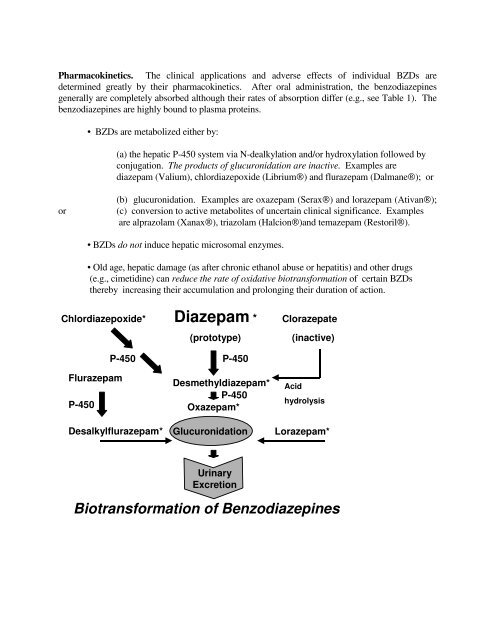Rang & Dale's Pharmacology, 6 Edition, 2007, Chapter 37 Objectives
Rang & Dale's Pharmacology, 6 Edition, 2007, Chapter 37 Objectives
Rang & Dale's Pharmacology, 6 Edition, 2007, Chapter 37 Objectives
Create successful ePaper yourself
Turn your PDF publications into a flip-book with our unique Google optimized e-Paper software.
Pharmacokinetics. The clinical applications and adverse effects of individual BZDs aredetermined greatly by their pharmacokinetics. After oral administration, the benzodiazepinesgenerally are completely absorbed although their rates of absorption differ (e.g., see Table 1). Thebenzodiazepines are highly bound to plasma proteins.• BZDs are metabolized either by:(a) the hepatic P-450 system via N-dealkylation and/or hydroxylation followed byconjugation. The products of glucuronidation are inactive. Examples arediazepam (Valium), chlordiazepoxide (Librium®) and flurazepam (Dalmane®); oror(b) glucuronidation. Examples are oxazepam (Serax®) and lorazepam (Ativan®);(c) conversion to active metabolites of uncertain clinical significance. Examplesare alprazolam (Xanax®), triazolam (Halcion®)and temazepam (Restoril®).• BZDs do not induce hepatic microsomal enzymes.• Old age, hepatic damage (as after chronic ethanol abuse or hepatitis) and other drugs(e.g., cimetidine) can reduce the rate of oxidative biotransformation of certain BZDsthereby increasing their accumulation and prolonging their duration of action.Chlordiazepoxide* Diazepam * Clorazepate(prototype)(inactive)P-450 P-450FlurazepamP-450Desalkylflurazepam*Desmethyldiazepam*P-450Oxazepam*GlucuronidationAcidhydrolysisLorazepam*UrinaryExcretionBiotransformation of Benzodiazepines
















